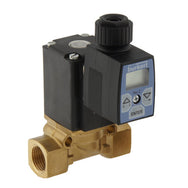Collection:Proportional Valves And Controllers
Subcategories
Proportional Valves And Controllers

A proportional solenoid valve accurately controls the fluid flow rate with a very fast response, rather than just completely opening or closing the valve. You can adjust process parameters by continuously regulating the fluid flow rate, such as fluid level, pressure, and temperature. A controller sends a signal to the proportional solenoid valve, instructing it to adjust its position in response to changes in the monitored process variable. The valve, in turn, modulates the flow of the medium—be it liquid or gas—to achieve the desired control effect.
Advantages
- Control proportional, process, and motor valves
- Certain models, for example, Burkert proportional valve has all operating parameters memorized
- The controllers can be easily connected to the proportional solenoid valve via DIN or screwed connections
- Excellent fluid adjustment characteristics
- Versatile functions like continuous, 2-point, 3-point, and on/off control.
- Fast response time, typically less than 15ms, and compact design.
When to choose a proportional valve and controller
- Variable flow control: Choose when precise adjustment of flow rates is required.
- Process stability: Needed for maintaining consistent pressure, temperature, or fluid levels.
- Energy efficiency: Ideal for applications where reducing energy consumption is a priority.
- Precision dosing/mixing: Essential for accurate chemical dosing or ingredient mixing.
- Noise reduction: Beneficial in environments where minimizing operational noise is important.
- Closed-loop control: Required for systems that need real-time feedback and automatic adjustments.
Proportional valve and controller applications
- Medical devices: Proportional solenoid valves precisely regulate the flow of oxygen and anesthetic gasses in ventilators and anesthesia machines.
- Industrial automation: They control the application of lubricants or coolants in automated machining processes to enhance tool life and product quality.
- HVAC systems: These valves modulate refrigerant flow in air conditioning units to maintain optimal indoor temperatures and energy efficiency.
- Automotive: Proportional valves adjust engine fuel and air mixtures for better performance and lower emissions.
- Water treatment: They are used to dose chemicals accurately in water treatment facilities, ensuring safe and consistent water quality.
Selection criteria
- Material: Ensure that the proportional valve material (like aluminum, brass, or stainless steel) matches the medium used.
- Connection size: Ensure the valve port size matches the internal diameter of the existing piping or tubing to ensure proper flow rates and seamless integration into the system.
- Flow characteristics: The valve must handle the required flow rates. This includes understanding the valve's flow coefficient (Cv), which indicates how much fluid can pass through the valve, and ensuring it matches the system's flow requirements.
- Type of controller input and outputs: This includes the type of input signal required from the sensor(e.g., temperature, flow, etc) and the controller outputs (like binary, PWM, 0-10V / 4-20mA, etc)
- Operating pressure: The valve should be rated for the operating pressure range of the system. Considering the minimum and maximum pressures the valve will encounter is important.
- Fluid compatibility: The materials of the valve's components must be compatible with the fluid it will control, whether it's air, water, oil, or aggressive chemicals. This includes the body material, seals, and other parts that come into contact with the fluid.
- Voltage and power requirements: The electrical characteristics of the solenoid, such as voltage and power consumption, should be compatible with the available power supply and control signals.
- Response time: The valve's response time should be suitable for the dynamics of the application. Faster response times are necessary for applications requiring quick flow or pressure adjustments.
- Temperature range: The valve must be able to operate within the temperature range of the application, both ambient and fluid temperature.
- Size and port connections: The physical size of the valve and the type of port connections must fit within the system's space constraints and be compatible with the existing piping or tubing. There are different connection types like DIn-A and screwed terminals.
- Control signal: The valve should be compatible with the type of control signal used in the system, like 0-10V, 4-20mA, or PWM).
- Resolution and hysteresis: The valve should have a high resolution to allow for fine control and low hysteresis to minimize variations in flow when the control signal changes.
- Duty cycle: The valve should be rated for the expected duty cycle in the application, which includes the frequency of operation and the duration of each cycle.
- Custom design options: Specialized design options like latching, energy efficiency, vacuum, position feedback, high temperature, and manual override are available for varying applications.





